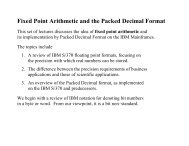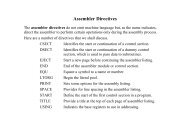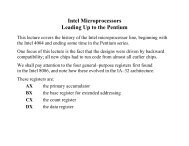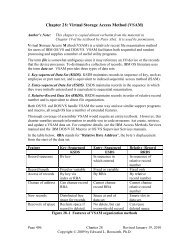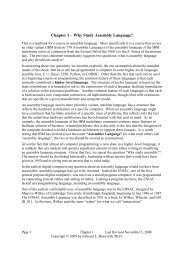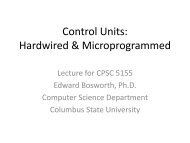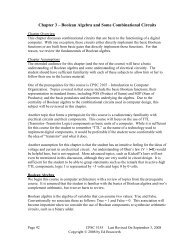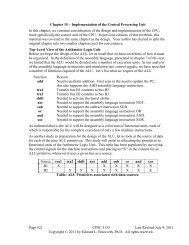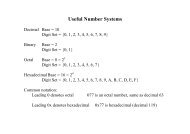Microprogramming: History and Evolution - Edwardbosworth.com
Microprogramming: History and Evolution - Edwardbosworth.com
Microprogramming: History and Evolution - Edwardbosworth.com
Create successful ePaper yourself
Turn your PDF publications into a flip-book with our unique Google optimized e-Paper software.
Wilkes’ Motivations<br />
―As soon as we started programming, we found to our surprise that it wasn’t<br />
as easy to get programs right as we had thought. … I can remember the exact<br />
instant when I realized that a large part of my life from then on was going to<br />
be spent in finding mistakes in my own programs.‖<br />
After his visit to the United States, Wilkes started to worry about the <strong>com</strong>plexity of the<br />
control unit of the EDVAC, then in design. Here is what he wrote later.<br />
“I found that it did indeed have a centralized control based on the use of a matrix<br />
of diodes. It was, however, only capable of producing a fixed sequence of eight<br />
pulses—a different sequence for each instruction, but nevertheless fixed as far as<br />
a particular instruction was concerned. It was not, I think, until I got back to<br />
Cambridge that I realized that the solution was to turn the control unit into a<br />
<strong>com</strong>puter in miniature by adding a second matrix to determine the flow of control<br />
at the microlevel <strong>and</strong> by providing for conditional microinstructions.”<br />
In other words, have the control signals emitted by a smaller <strong>com</strong>puter that is controlled<br />
by a microprogram. The advantage is that the control unit of this smaller <strong>com</strong>puter is<br />
extremely simple to design, test, <strong>and</strong> underst<strong>and</strong>.



